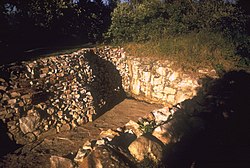Pipestone National Monument
Cannomok'e--Pipestone National Monument | |
 | |
| Location | Sweet Township, Pipestone County, Minnesota |
|---|---|
| Nearest city | Pipestone, Minnesota |
| Area | 281.78 (1.14 km²) |
| Visitation | 69,820 (2005) |
| MPS | Pipestone County MRA (AD) |
| NRHP reference No. | 66000112[1] |
| Significant dates | |
| Designated HD | October 15, 1966 |
| Designated NMON | August 25, 1937 |
Pipestone National Monument is located in southwestern Minnesota, just north of the city of Pipestone, Minnesota. It is located along the highways of U.S. Route 75, Minnesota State Highway 23 and Minnesota State Highway 30.
The catlinite, or "pipestone", has been traditionally used to make ceremonial pipes, vitally important to traditional Plains Indian religious practices. The quarries are sacred to most of the tribe of North America, Dakota, Lakota, and other tribes of Native Americans, and were neutral territory where all Nations could quarry stone for ceremonial pipes.[2] The Sioux tribes may have taken control of the quarries around 1700, but the Minnesota pipestone has been found inside North American burial mounds dating from long before that, and ancient Indian trails leading to the area suggest pipestone may have been quarried there for many centuries.[3]
As the United States grew westward in the 19th century, pipes found their way into white society through trade. To protect their source, the Yankton Sioux secured free and unrestricted access via The Treaty With The Yankton Sioux, which was signed on April 19, 1858.
The land was acquired by the federal government in 1893. In 1928, the Yankton Sioux, then resettled on a reservation 150 miles (240 km) away, sold their claim to the federal government. The National Monument was established by an act of Congress on August 25, 1937, and the establishing legislation restored quarrying rights to the Indians.[2] Today only people of Native American ancestry are allowed to quarry the pipestone. A boundary change occurred on June 18, 1956.[4] As an historic area under the National Park Service it was administratively listed on the National Register of Historic Places under the heading "Cannomok'e—Pipestone National Monument". The Red Pipestone Quarries within the monument comprise a Minnesota State Historic Site.[5]
During the summer months, there are cultural demonstrations at the monument. The Upper Midwest Indian Cultural Center, located inside the visitor center, sponsors demonstrations of pipemaking by native craftworkers using the stone from the quarries. Local Native Americans carve the stones using techniques passed down from their ancestors. Many of the demonstrators are third or fourth generation pipe makers.
Visitors can also walk along a three-quarter mile (1.2 km) self-guided trail to view the pipestone quarries and a waterfall. A trail guide is available at the visitor center. About 260 acres (1.1 km2) of the national monument has been restored to native tallgrass prairie. Monument staff burn prairie parcels on a rotating basis to control weeds and stimulate growth of native grasses. A larger area of restored tallgrass prairie and a small Bison herd are maintained by the Minnesota DNR at Blue Mounds State Park, 20 miles (32 km) to the south.
The visitor center features exhibits about the natural and cultural history of the site, including a petroglyph display. There is also an orientation video about the history of the pipestone quarries.
-
Historic pipestone quarry
-
Pipestone crafting demonstration at Pipestone National Monument
-
Picture of Winnewissa falls
References
- ^ "National Register Information System". National Register of Historic Places. National Park Service. March 13, 2009.
- ^ a b "Pipestone National Monument - People". National Park Service. Retrieved February 16, 2012.
- ^ Pipestone County Museum - History
- ^ The National Parks: Index 2001–2003. Washington: U.S. Department of the Interior.
- ^ "Minnesota Statute § 138.57, subd. 4". Minnesota Revisor of Statutes. Retrieved 2007-02-26.
{{cite web}}: Cite has empty unknown parameter:|coauthors=(help)
External links
- Official NPS website: Pipestone National Monument
- National Monument Holds Ancient Pipestone Quarries (travel article)
- 1937 establishments in Minnesota
- Archaeological sites on the National Register of Historic Places in Minnesota
- Historic districts in Minnesota
- Monuments and memorials in Minnesota
- Museums in Pipestone County, Minnesota
- National Park Service National Monuments in Minnesota
- Native American history of Minnesota
- Native American museums in Minnesota
- Pipe smoking
- Protected areas established in 1937
- Protected areas of Pipestone County, Minnesota
- Quarries in the United States
- Religious places of the indigenous peoples of North America
- Dakota
- Lakota




